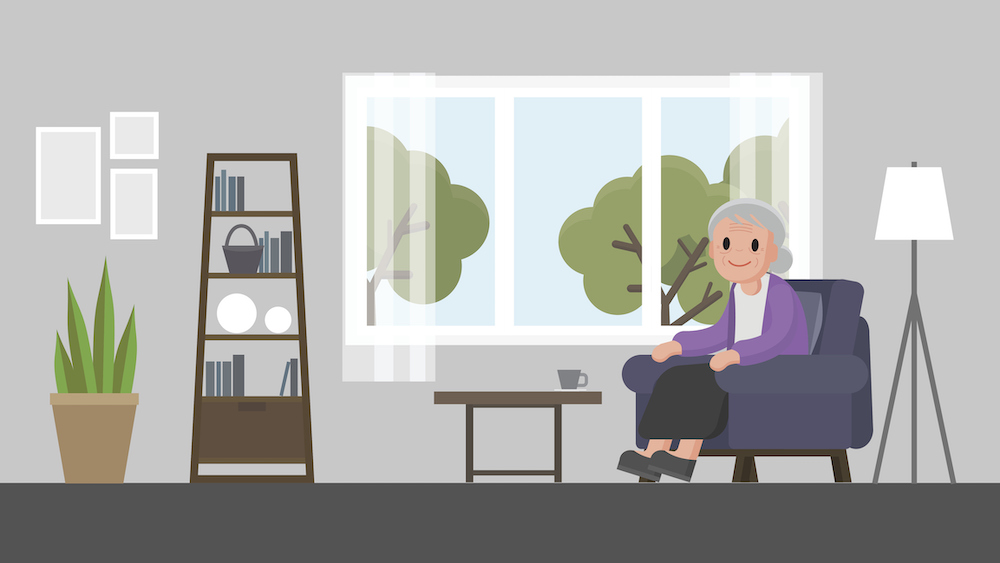Aging in Place or Home Alone?

One of the most active and fascinating growth spaces in marketing to age is the technological innovation that will help millions of people to "age in place"; i.e., to age successfully in the comfort of their own home. Yet, for all that's being said about these technological advances, no one's talking about the emotional consequences of aging in isolation. It's great that mom is aging in her own home instead of a nursing home, but what happens when she realizes that she's actually home alone?
While the aging space has been ignored by many businesses simply because it's not glamorous or trendy, tech companies have been all too eager to tap the aging trend and penetrate households in the process. There's no limit to the types of home-monitoring and assisted-living systems that are being installed in the homes of aging consumers — all with the admirable goal of helping these older consumers live comfortably and safely while reassuring their eavesdropping children that mom's or dad's choice to stay put was a good one.
Despite all the life-changing improvements that this technology offers, it's also helping to enable a choice that has some blind downsides. You see, technology has this habit of replacing people. If you're a younger consumer — say, a millennial — this is almost always a good thing. Millennials continually demonstrate a preference to interact with brands using technology-driven, rather than human, interfaces (think, ordering from a kiosk at McDonald's or live messaging with a customer service agent instead of calling). But if you're an older person who's aging in place and potentially doing it alone, you're also likely yearning for the social connectedness that requires human contact.
Maslow had this right all those years ago. Right up there with our physiological needs (e.g., food, water, and shelter) is our need for love and belonging (e.g., friendship, intimacy, family, and a sense of connection). If an aging person decides to live at an assisted-care facility, it comes with human assistants who can help with health and safety, but, just as important, provide love and belonging, too. Similarly, retirement communities come with a built-in community. If the baby boomers of the future are going to decide to age in their own homes — and why wouldn't they — then we need to begin to prepare now to ensure that the technology they'll be using is augmented with some touch.
Here are some things we can begin to think about:
Getting Out and About
One of the risks of aging in place is being stuck in place. Mobility will be critical, as it enables freedom (another of Maslow's needs) and helps bring people together. We need to look to the growing ride-share industry to help solve this. Two start-ups — SilverRide and GoGo Grandparents — are already providing door-to-door, hands-on mobility services for elders, but the challenge of cost-effectiveness still looms. Although most people prefer to age in their own homes, the undeniable advantage of assisted-care facilities is that they operate at scale. It's going to be challenging to make personalized one-on-one ride services viable. We're going to need to figure out how we're going to move 77 million aging boomers.
Communal Living Alternatives
If aging people want to age in the comfort of a home instead of a nursing home, and they need to be around other people, why don't we help other people move in? This could be other aging people who are also looking for companionship, or it could be younger people who are in transition and need affordable housing. The technology to match people exists, but it hasn't been applied to aging in place because we've yet to fully envision the needs that will emerge in this space.
Another option is for boomers to plan ahead now. Communal living is a viable and interesting option for empty nest boomers who might be reluctantly downsizing from the large home they love being in. Perhaps it's time for them to think creatively about their current real estate choices with the future in mind. A large home with a pool shared by three couples who are a blast to be around now — and who can nurture and support each other in their later years — is sure worth thinking about.
Visiting Services
Most of the visiting services available today address a specific medical need that requires intervention. These services are usually extensions of local medical care networks and are paid for by Medicare. But what about social needs like love and belonging that don't come with a diagnosis and aren't covered by insurance? And where are all of the emotional caregivers going to come from?
Here's a thought: Let's focus on the baby boomers of today who anticipate aging in place and will eventually need emotional companionship. What if they began to volunteer their time now to assist today's older people in return for the same level of service in the future? That future quid pro quo care would be provided by another aging person who's also proactively anticipating their own future need — a virtuous cycle of care.
Think of this as a different kind of social security — an investment of time now in return for "social security" and emotional wellness in the future. No money changing hands, people helping other people with everyone being better for the experience.
Don't Go It Alone
I've often said that people react to aging in irrational ways, and the decision to age in place is no exception. Elders have always had a bias to stay in their own homes, but they haven't typically prevailed, as adult children and caregivers have been wise to urge a safer retirement-home alternative.
With the advent of assisted-living technology, there's now a justification for letting mom have her way. The technology is real, and it does smart things, so the decision feels rational — but it's really not. Seventy-seven million baby boomers are approaching an age where this type of decision is going to play out somewhere every day.
Although technology that supports aging in place will keep advancing, as long as that technology is replacing humans in some way, people of age will still need a lot of touch to go along with their tech. In the end, there really is no place like home. Let's plan now to make sure our aging boomers don't end up home alone.
Photo courtesy of BoomAgers.
Click the social buttons to share this story with your friends and colleagues.
The opinions and points of view expressed in this content are exclusively the views of the author and/or subject(s) and do not necessarily represent the views of MediaVillage.com/MyersBizNet, Inc. management or associated writers.


